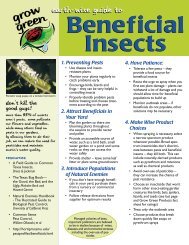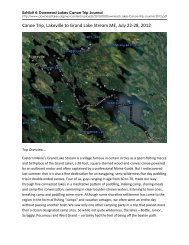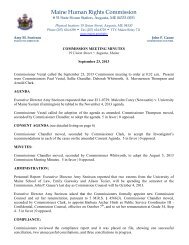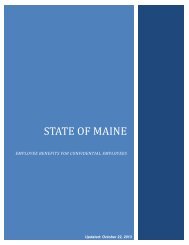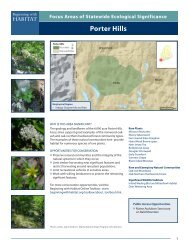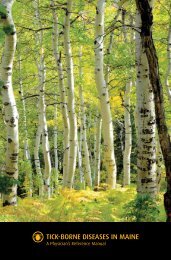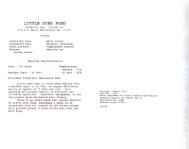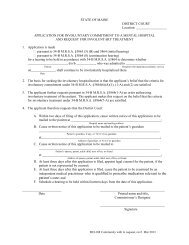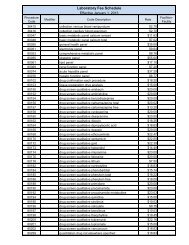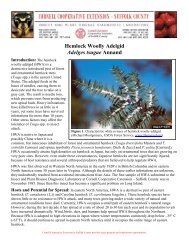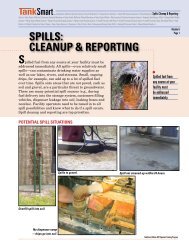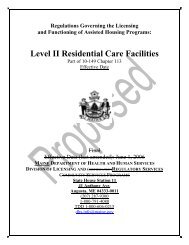Maine Department of Transportation Caribou Connector ... - Maine.gov
Maine Department of Transportation Caribou Connector ... - Maine.gov
Maine Department of Transportation Caribou Connector ... - Maine.gov
Create successful ePaper yourself
Turn your PDF publications into a flip-book with our unique Google optimized e-Paper software.
SPECIAL PROVISION<br />
SECTION 656<br />
Temporary Soil Erosion and Water Pollution Control<br />
Special Provision 656 - Page 2 <strong>of</strong> 3<br />
<strong>Caribou</strong><br />
6462.30<br />
April 26, 2010<br />
10) Temporary winter stabilization must be used between November 1 st and April 1 st<br />
or outside<br />
<strong>of</strong> that time period if the ground is frozen or snow covered. Temporary winter stabilization<br />
involves, at a minimum, covering all disturbed soils and seeded ground that is not Acceptable<br />
Work with an approved method. If temporary winter stabilization practices are used then spring<br />
procedures for permanent stabilization shall also be described in the SEWPCP. Use <strong>of</strong> these<br />
methods for over-winter temporary erosion control will be incidental to the contract and be paid<br />
for as part <strong>of</strong> Pay Item 656.75.<br />
11) DRAINAGE WORK SHALL NOT COMMENCE UNTIL AFTER APRIL 1 OF<br />
ANY YEAR DUE TO HIGH GROUNDWATER LEVELS AND NUMEROUS<br />
INTERMITTENT STREAMS. This date shall only be adjustable upon approval <strong>of</strong> both the<br />
Construction Manager and a representative from the Water Resources Unit.<br />
12) All disturbed ditches/slopes shall be stabilized by the end <strong>of</strong> each workday. Stabilization<br />
shall be maintained on a daily basis.<br />
13) Erosion control blanket shall be installed in the bottoms <strong>of</strong> all ditches except where a stone<br />
lining is planned. Seed shall be applied prior to the placement <strong>of</strong> the blanket.<br />
14) If check dams are used, they shall be constructed <strong>of</strong> stone in accordance with BMP Manual,<br />
Section III.E.1. Hay Bale Temporary Check Dams are not allowed. Delete all reference to them.<br />
15) Demolition debris (including debris from wearing surface removal, saw cut slurry, dust,<br />
concrete debris, etc.) shall be contained and shall not be allowed to discharge to any resource.<br />
All demolition debris shall be disposed <strong>of</strong> in accordance with Standard Specifications, Section<br />
202.03, Removing Existing Superstructure, Structural Concrete, Railings, Curbs, Sidewalks and<br />
Bridges.<br />
Containment and disposal <strong>of</strong> demolition debris shall be addressed in the Contractor's<br />
SEWPCP.<br />
16) CLEARING LIMIT LINES SHALL BE MINIMIZED. Clearing shall be minimized as<br />
shown on the design plans.<br />
17) Stream flow shall be maintained at all times.<br />
18) If a c<strong>of</strong>ferdam sedimentation basin is used, it shall be located in an upland area where the<br />
water can settle and sink into the ground or be released slowly to the resource in a manner that<br />
will not cause erosion. The location <strong>of</strong> such a c<strong>of</strong>ferdam sedimentation basin shall be addressed<br />
in the SEWPCP.<br />
19) Prior to release to a natural resource, any impounded water that has been in contact with<br />
concrete placed during construction must have a pH between 6.0 and 8.5, must be within one pH<br />
unit <strong>of</strong> the background pH level <strong>of</strong> the resource and shall have a turbidity no greater than the<br />
receiving resource. This requirement is applicable to concrete that is placed or spilled (including<br />
leakage from forms) as well as indirect contact via tools or equipment. Water not meeting<br />
release criteria shall be addressed in the SEWPCP. Discharging impounded water to the stream<br />
must take place in a manner that does not disturb the stream bottom or cause erosion.<br />
ST



